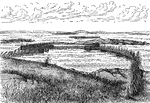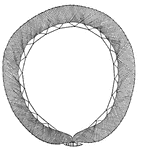Clipart tagged: ‘fisheries’

Gill-net
A net that catches fish with gill covers in the mesh of the net. This illustration shows a gill-net…

Herring Weir
A fixed trap that fish can easily find their way into, but cannot easily find their way out. This particular…

Pound Net
This net employs a 'Leader', 'Heart', 'Fore Bay', and 'Pound'. Each of these apparatus are constructed…

Purse-seine
A 'purse' seine is a form of fishing net that is paid out around a school of fish, like a cylinder with…